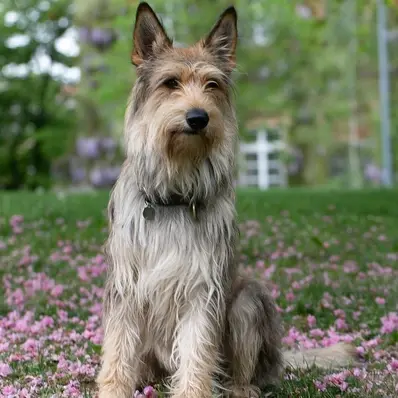Berger Picard History/Origin
French agriculture remained strong even after the Industrial Revolution, and farming is still important to the country today. They are one of the oldest herding dogs in France, possibly brought by ancient Celts. It’s closely related to other French herding breeds like the Briard and Beauceron. The name “Berger Picard” comes from the Picardy region, known for its rich pastures.
Farmers in Picardy took pride in their native sheepdog, which was shown in France’s first dog show in 1863. Dedicated breeders worked to standardize the Picard’s appearance by the 1900s.
A woodcut of Berger Picard- Source: Wikipedia
Both world wars were hard on the Picard breed, especially World War II because Picardy was a battlefield. But despite nearly going extinct, the breed has made a comeback. The Berger Picard gained attention when one starred in the 2005 movie ‘Because of Winn Dixie.’ In 2015, the Berger Picard Club of America joined the American Kennel Club under Herding Group, further raising the breed’s profile.
Because of Winn Dixie- Source: IMDb
Berger Picard Personality
The Berger Picard is super smart, making it easy to train and solve problems. These purebred dogs love mental challenges and forming strong bonds with their families. They’re loyal and show lots of love and affection.
With strangers, they’re a bit reserved and cautious, which is great for keeping their loved ones safe. Sometimes they can be stubborn, but with patient training, it’s manageable.
- Berger Picard Temperament
They’re one of the dog breeds that are adaptable dogs, able to thrive in different environments, as long as they get enough exercise and mental stimulation. Because they were originally herding dogs, they might try herding people or other pets.
With early training and socializing, Berger Picards are awesome family pets, known for their intelligence, loyalty, and independent nature.
Here’s a video of Berger Picards featuring in the dog show 2023:
Berger Picard Physical Appearance
The Berger Picard has a shaggy, wiry coat that protects it from tough weather. Its head is wedge-shaped with a strong muzzle and alert ears. Their eyes are almond-shaped and dark, giving them a smart look. They have a medium-sized, muscular body with a straight back. Overall, they have a distinctive and strong appearance.
- Berger Picard Size
At 6 months, the Berger Picard weight and height were 17.0 inches tall and 17.5 lbs. By 12 months, it grew to 24.0 inches tall and weighed 30.0 lbs. At 18 months, it stayed at 24.0 inches tall but gained more weight, reaching 52.5 lbs.
- Coat color
The Berger Picard’s coat is medium-length and weatherproof, feeling harsh and crisp when touched. It comes in various shades of fawn and gray, such as light fawn, dark fawn, gray, gray with black highlights, blue-gray, gray-red, and brindle.
Berger Picard Gender Differences
In terms of gender differences, Berger Picard displays minimal distinctions. Generally, males are slightly larger and may weigh a few pounds more than females, showcasing subtle variations in size and robustness.
Berger Picard Feed/Nutrition
Berger Picards thrive when fed a high-quality diet rich in protein. It’s recommended to provide them with two meals a day, adjusting their caloric intake based on their activity level and size. Whether commercially manufactured or home-prepared with your veterinarian’s guidance, ensure the diet is suitable for the dog’s age (puppy, adult, or senior).
Given their athletic nature, it’s essential to ensure they receive adequate nutrition to meet their needs. However, be cautious about overfeeding, as some dogs may be prone to obesity. Treats such as oranges can aid in training but should be given in moderation to prevent weight gain.
Familiarize yourself with safe human foods for dogs and consult your vet if you have any concerns about your dog’s weight or diet. Additionally, always provide clean, fresh water for your Berger Picard.
Berger Picard Health
The Berger Picard is typically healthy due to responsible breeding practices. However, they can be susceptible to specific health issues such as hip and elbow dysplasia, as well as eye disorders like progressive retinal atrophy. Regular veterinary checkups, even if your dog appears well, are crucial for maintaining their overall health and longevity.
- Hip dysplasia: Hip dysplasia is a common condition in dogs where the hip joint doesn’t develop properly, causing loss of function. Surgery can correct it by replacing the joint with implants. With treatment, dogs can live long, happy lives. Symptoms include limping, lameness, decreased muscle mass, pain, and difficulty moving.
- Progressive Retinal Atrophy: Berger Picards can develop progressive retinal atrophy (PRA), an inherited condition that affects the cells in the retina, leading to potential blindness. Although there’s no cure, dogs typically adjust to vision loss. Signs include trouble seeing at night, difficulty following commands, cloudy eyes, and bumping into things.
Berger Picard Care and Grooming
The Berger Picard has a double coat, with a soft undercoat and a shaggy, waterproof outer coat. During shedding season, it’s best to brush them every day or two to remove loose hair. Throughout the rest of the year, brushing once a month is usually enough. They don’t need frequent baths, and using shampoos made for their type of coat is best. Their nails should be trimmed regularly.
Overall, they’re low-maintenance dogs because their rough coat doesn’t easily tangle or mat. Grooming them once a week or every other week with a pin brush and metal comb keeps them looking tidy.
Pay extra attention to the hair behind their ears to prevent tangles. Clean their ears weekly to prevent infections, and comb their beard to remove food particles. Keeping up with dental care is important for their overall health. Additionally, crate training your dog provides them with a safe, secure space and can help with house training.
Disclaimer: The Picard breed may not be suitable for first-time dog owners due to their unique traits and training requirements. Experience with herding or guardian breeds is recommended.
Berger Picard Rescue Groups
Many Berger Picards need homes despite their wonderful qualities. While they’re not common in the United States, you might find one through rescue networks. Adoption is always encouraged.
Berger Picard Price
The price of a Berger Picard typically ranges from $2,000 to $2,500, depending on the breeder and the dog’s pedigree.
When purchasing from breeders, ensure they are reputable and prioritize the health and well-being of their dogs.
Interesting Facts
- Berger Picard “Beegee” won Best in Show at the 2020 AKC National Owner-Handled Series Finals.
Beegee- Source: AKC.org
- The Berger Picard named “Loupy”, a show champion and instinctive diabetic alert dog.
Loupy- Source: AKC.org
- They have won the best-in-show award in Silver Kennel Club 2019.
Source: toucha Berger Picard
Best For
Berger Picards are best suited for active individuals or families who enjoy outdoor activities and are committed to forming a strong bond with their pets. Prospective owners should be patient, willing to provide socialization and training, and prepared to invest time in grooming their dog’s coat.
Top Names
| Male Berger Picard Names | Female Berger Picard Names |
| Max | Luna |
| Leo | Bella |
| Charlie | Daisy |
| Toby | Sadie |
| Rocky | Molly |









 A woodcut of Berger Picard- Source:
A woodcut of Berger Picard- Source:  Because of Winn Dixie- Source:
Because of Winn Dixie- Source: 

 Fawn Berger Picard- Source:
Fawn Berger Picard- Source:  Grey Berger Picard- Source:
Grey Berger Picard- Source: 
 Beegee- Source:
Beegee- Source:  Loupy- Source:
Loupy- Source:  Source:
Source: 






